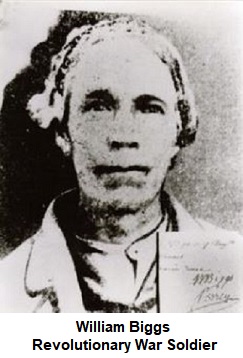William Biggs (1755 - 1827)
Revolutionary War soldier; Illinois Legislator; Sheriff; Held Captive by the Kickapoo Indians

At the age of twenty-three, William enlisted as a soldier in the
Revolutionary War, and became a member of George Rogers Clark’s
famous expedition. He was hardy, energetic, and brave. He withstood
the perils and hairbreadth escapes incident to the Clark campaign,
with the heroism of a veteran warrior. Soon after the close of the
war, he went back to his old home in the east, and in 1810 he
married Mary Ann Judy Lunceford (1773-1852), widow of George
Lunceford (1762-1808). Mary Ann and George Lunceford had a son,
William Lunceford (1796-1876). It is unknown if William and Mary Ann
had any children. Biggs, his family, and his two brothers and their
families immigrated to Illinois, and settled at Bellefontaine.
On March 28, 1788, Biggs was captured by Kickapoo Indians. He was
going from Bellefontaine to Cahokia, in company with a young man
named John Vallis. At 7a.m., they heard two guns fire, thinking it
was nearby hunters. After a moment, Biggs looked to his left and saw
sixteen Indians, standing with their guns pointed at them at about
forty yards away. Biggs urged his horse into a run, and told his
companion to do the same. At that moment, the Indians fired their
guns, putting four bullets into Biggs’ horse, and four or five
through Biggs’ green coat, without wounding him. They then ran
toward Biggs and Vallis, yelling frightfully, which scared his horse
so much that it jumped to one side of the road, causing Biggs, his
gun, and his saddle to fall off. Biggs tried to mount again, but
with no saddle on the horse, he found it difficult to do. He did
manage to hang onto the horse’s mane for about twenty or thirty
yards, but his hold broke and he fell on his hands and knees to the
ground. By the time he got to his feet, the Indians were about eight
or ten yards away. Biggs turned to run, but the Indians were close
behind, and he was eventually captured. His companion, John Vallis,
reached the fort with a severe wound, of which he died after
lingering six weeks. Biggs’ horse was later found dead from the
bullet wounds he received. Signal guns were fired to alarm the
community of the capture of Biggs and a possible attack. The
Indians, hearing the gun report, hurried away with their prisoner.
The Indians kept Biggs running for five or six miles toward their
village called Weastown, on the Wabash River. The distance to their
village was nearly three hundred miles, but they reached it in ten
days with their prisoner in tow. One of the Indians tried to kill
Biggs, but the others had something else in mind - a large ransom.
Biggs was severely mistreated, and each night he was tied to a tree
so he couldn’t escape. Negotiations began at Vincennes for his
ransom by John Rice Jones. An agreement was finally reached, where
the Indians received the equivalent of $260 for Biggs’ freedom.
Biggs also promised $37 for the means necessary to accomplish his
journey back to Bellefontaine. He went down the Wabash River in a
canoe to the Ohio River, and then to the Mississippi River, and up
to Kaskaskia, where he had only a few miles to travel overland to
reach his home. The return to his family was jubilant, as they
feared he was dead. In 1826, Biggs published a narrative of his
captivity with the Kickapoo Indians, which can be found on Google
Books or Amazon (“Narrative of the Captivity of William Biggs”).
Governor St. Clair, in 1790, appointed Biggs Sheriff of St. Clair
County, an office he held many years. Biggs and fellow soldier,
Shadrach Bond (future Governor of Illinois), were both elected
members of the first General Assembly of the Northwest Territory.
Biggs also served as Justice of the Peace and Judge of the Court of
Common Pleas. In 1808, he was elected to the Legislature of the
Indiana Territory, and helped to secure the division of the
Territory. Biggs was twice elected to serve in the Illinois
Territorial Legislature, convened at Kaskaskia, Illinois, on
November 25, 1812 and November 14, 1814, representing St. Clair
County.
In 1823, William Biggs, sunk a salt well near the banks of Silver
Creek, in section 19 of Saline Township, Madison County, Illinois.
There was a natural salt lick there, which attracted deer and cattle
at an early day. William struck solid rock at a depth of thirty
feet, and continued the shaft to a distance of four hundred and
forty feet below the surface, when salt water began to flow. Into
the shaft, he set the trunk of a hollow sycamore tree, cemented to
the rock. Biggs invested a considerable amount of money in the
works. He had 40 large kettles for evaporating purposes, and fifteen
cords of wood per day were used in making six bushels of salt. About
twenty men were employed in the works. The experiment was expensive,
and ended in failure. The creek has since changed its course, that
now the old salt well is in the bed of the stream. Saline Township
in Madison County was named after the salt content it contains.
In 1826, Congress granted Biggs three sections of land for services
rendered to the colonies in the Revolutionary War. Biggs, an aged
and respected pioneer, died near the future town of Glen Carbon the
following year (1827) at the residence of Colonel Samuel Judy Sr.,
his brother-in-law. He is buried in the Nix-Judy Pioneer Cemetery in
Glen Carbon.